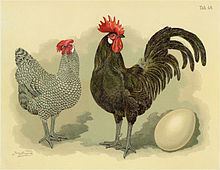Other names Elberfelder Use dual-purpose Scientific name Gallus gallus domesticus Higher classification Chicken | Country of origin Germany Egg colour white Origin Germany Rank Breed | |
 | ||
Conservation status FAO (2007): not listedGEH: extremely endangered Weight Male: 2.0-2.75 kgFemale: 1.75-2.25 kg Similar Bergische Kräher, Deutscher Sperber, Westfälischer Totleger, Ramelsloher, Sundheimer | ||
The Bergische Schlotterkamm is an old and endangered German breed of domestic chicken. It originates from the Bergisches Land, in the state of North Rhine-Westphalia in western Germany, and is one of three chicken breeds from that area, the others being the Bergische Kräher and the Krüper.
Contents
History
The breed has been known since the eighteenth century and is probably the result of crossing imported Spanish birds with local Bergische Kräher stock. At the beginning of the nineteenth century the breed experienced competition from imported multi-purpose breeds such as the Minorca, and became almost extinct. A breed association, the Vereinigung der Züchter Bergischer Hühnerrassen, was formed in 1884.
Today the Bergische Schlotterkamm is an endangered breed. In 2001 it was an "endangered breed of the year" of the Gesellschaft zur Erhaltung alter und gefährdeter Haustierrassen; it is listed in category I, "extremely endangered", on the Rote Liste of that organisation.:162 In 2013 the total population was around 250.
A bantam version of the Schlotterkamm was created in the late twentieth century by cross-breeding bantam Bergische Kräher and Thüringer Barthuhn birds. It is found in one plumage colour only, Silver-laced Black, and is even rarer than the full-sized Schlotterkamm.
Characteristics
The Schlotterkamm is a medium-sized dual-purpose chicken. The shape is long and somewhat rectangular. It has a single comb which flops from one side to the other; it is this that gave the breed its name. Four plumage colours – Cuckoo, Silver-laced Black, Gold-laced Black and Black – have been recognised since 1896. The old Cuckoo variant had virtually disappeared by 1922, and the white Schlotterkamm disappeared as the Leghorn breed became more popular.
Use
The Schlotterkamm is a dual-purpose breed, reared both for eggs and for meat. Hens lay about 150 eggs per year; the eggs are white and weigh about 55 g. The hens have little tendency to broodiness.
